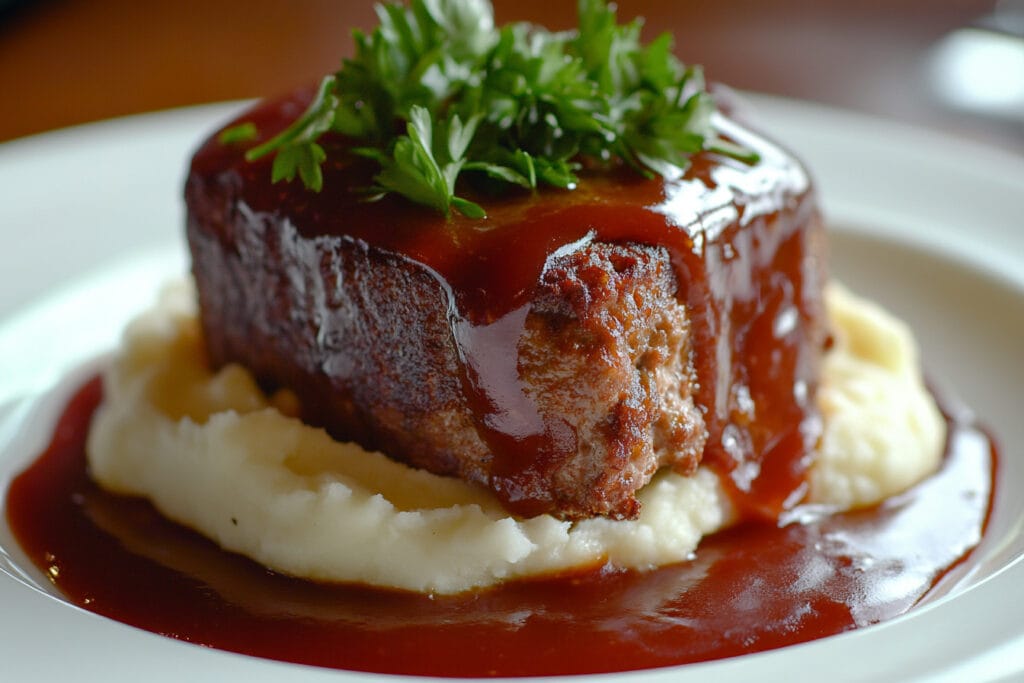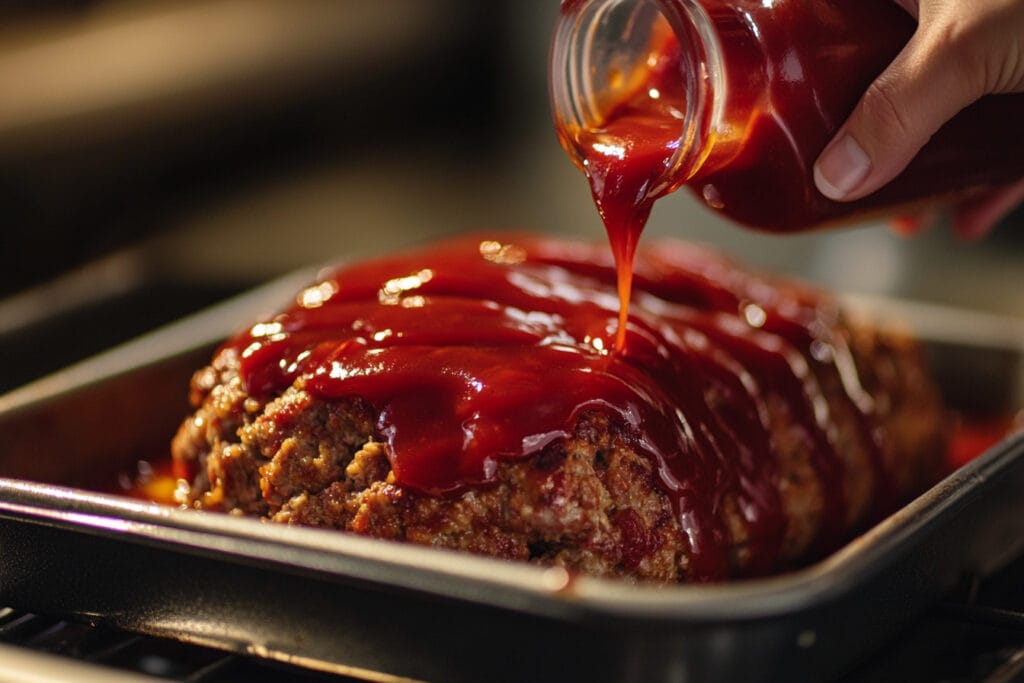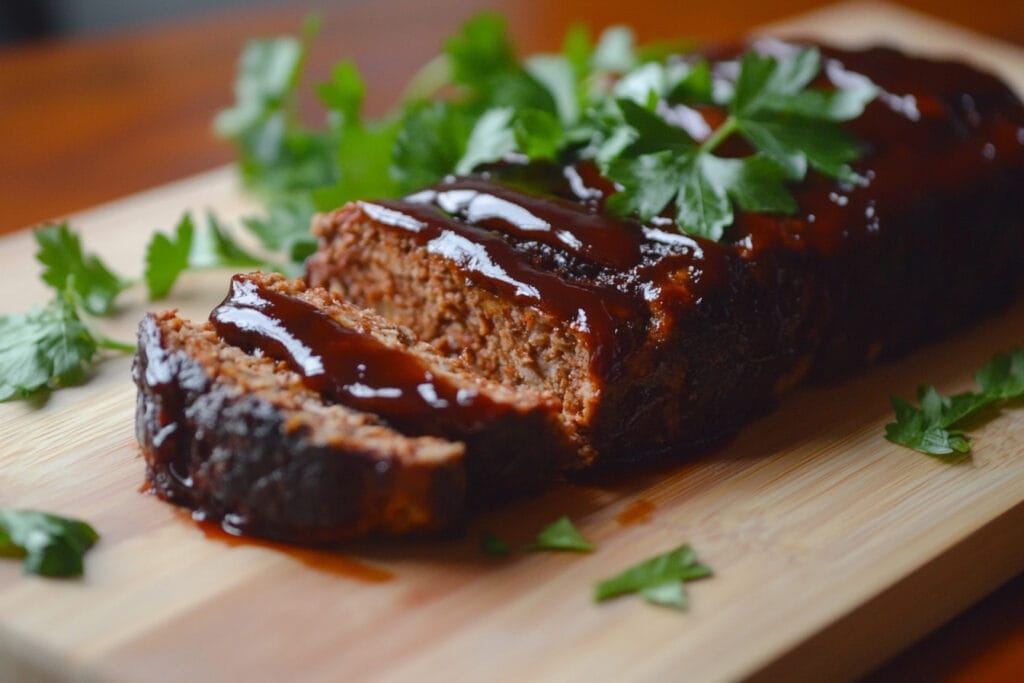
Meatloaf, a classic comfort food, is a dish beloved by many families around the world. Known for its simplicity and hearty texture, meatloaf is typically made by mixing ground meat with breadcrumbs, eggs, and seasonings, and then baking it to perfection. However, one ingredient that often sparks curiosity and debate is ketchup. Why is it such a common addition to this dish?
The tradition of putting ketchup in meatloaf can be traced back to early 20th-century America, where convenience foods like ketchup became a staple in home kitchens. Over the years, ketchup has become more than just a topping; it is often mixed directly into the meatloaf or spread on top as a glaze. Its unique blend of sweetness, tanginess, and acidity enhances the flavor of the meatloaf, making it more appetizing for both kids and adults alike.
But ketchup does more than just add flavor. It plays a key role in the texture and moisture of the meatloaf, keeping it from drying out during the baking process. In this article, we’ll explore the reasons why ketchup is such a popular choice for meatloaf, including its chemical properties, cultural significance, and potential alternatives. By the end, you’ll have a deeper understanding of why this humble condiment is a meatloaf hero.
The Role of Ketchup in Meatloaf
When it comes to making meatloaf, ketchup is more than just an afterthought. This condiment plays an essential role in elevating the dish, adding layers of flavor and enhancing the overall texture. But why exactly does ketchup work so well in meatloaf?
Ketchup as a Flavor Enhancer
One of ketchup’s superpowers is its ability to amplify flavors. Ketchup contains a unique combination of sweet, tangy, and salty elements that complement the savory taste of ground meat. It creates a perfect balance that prevents meatloaf from tasting overly bland or too heavy.
Ketchup’s sweetness comes from sugar or corn syrup, which cuts through the richness of the meat. Meanwhile, its tanginess—thanks to the vinegar—adds a sharp contrast that livens up the dish. This harmonious combination makes meatloaf taste more exciting, which is why ketchup has become a staple in many recipes.
Balancing Sweetness and Acidity
Every dish benefits from balance, and meatloaf is no exception. Ground meat, while delicious, can sometimes taste overly fatty or monotone. Ketchup fixes this issue by bringing acidity to the table. The slight sourness from the vinegar in ketchup helps to balance out the richness of the meat, creating a more well-rounded flavor profile.
Additionally, the sweetness of ketchup makes it appealing to a wide range of people, especially kids. For those who may find the savory taste of meatloaf too intense, ketchup provides a familiar and friendly flavor that makes the dish more approachable.
Why Ketchup Works with Ground Meat
Ground meat is the heart of any meatloaf, but it can sometimes lack flavor on its own. Without the right seasonings and ingredients, meatloaf can turn out dry or one-dimensional. This is where ketchup shines.
When mixed into the meatloaf mixture, ketchup acts as both a binder and a flavor booster. It keeps the ingredients evenly distributed while infusing the meat with its iconic taste. When spread on top of the loaf as a glaze, ketchup caramelizes in the oven, creating a slightly sticky, tangy-sweet crust that contrasts beautifully with the tender interior of the meatloaf.
Ketchup’s thick consistency also ensures that it doesn’t just drip off the meatloaf during cooking. It clings to the surface, forming a glossy topping that adds both flavor and visual appeal. For many people, this signature ketchup glaze is what makes meatloaf feel complete.

Scientific Reasons Behind Ketchup’s Impact
To understand why ketchup is such a vital part of meatloaf, we need to look at the science behind it. Ketchup isn’t just a random ingredient thrown in for taste—it has chemical properties that improve the overall texture, moisture, and flavor profile of the dish. Let’s explore how this works.
The Chemistry of Ketchup
Ketchup is a carefully balanced product that combines key ingredients: tomatoes, vinegar, sugar, salt, and spices. Each of these components has a role to play in the chemistry of meatloaf.
- Tomatoes: The base of ketchup is tomatoes, which are naturally rich in umami, the “fifth taste” that adds depth and savoriness to dishes. Umami works particularly well with meat, enhancing its natural flavors and making the meatloaf taste more robust.
- Vinegar: The acidity in vinegar acts as a tenderizer for the meat. By breaking down some of the proteins, it helps create a softer, more tender texture. Additionally, vinegar’s sharpness balances out the rich, fatty flavors of the meat.
- Sugar: Sugar in ketchup helps with caramelization during baking. As the ketchup glaze heats up, the sugars melt and brown, forming a sticky, slightly crunchy crust on top of the meatloaf. This layer adds texture and visual appeal, making the dish feel extra special.
- Salt and Spices: The salt and spices in ketchup bring out the natural flavors of the meat, acting as a seasoning agent. These flavors are subtle but essential for creating a cohesive and delicious dish.
Enhancing Texture and Moisture
One common challenge when making meatloaf is keeping it moist. Ground meat can dry out easily in the oven, especially if it’s cooked for too long or lacks the right balance of ingredients. Ketchup helps to prevent this problem in two ways.
- Moisture Retention: When mixed into the meatloaf, ketchup adds moisture to the mixture. Its thick, liquid consistency ensures that the meat stays juicy even as it cooks. This is particularly important because dry meatloaf can ruin the entire eating experience.
- Preventing Overcooking: The glaze of ketchup on top acts as a protective barrier, helping to trap moisture inside the meatloaf. It also shields the surface from excessive heat, preventing the outer layer from becoming overly dry or burnt.
How Ketchup Enhances Flavor Through Heat
Cooking ketchup changes its flavor in subtle but important ways. As it heats up in the oven, the sugars and acids in ketchup undergo chemical reactions, such as caramelization and the Maillard reaction. These processes create new flavors that are deeper, sweeter, and more complex.
The result is a topping that not only looks appetizing but also tastes incredible. The slight stickiness of the glaze adds texture, while the intensified flavors provide a contrast to the tender, savory meat below. This combination of textures and tastes is what makes meatloaf with ketchup so satisfying.
Alternatives to Ketchup in Meatloaf
While ketchup is a classic choice for meatloaf, it’s not the only option. Some people prefer to experiment with other ingredients to create new flavor profiles or cater to dietary preferences. Whether you’re looking for tomato-based alternatives or entirely different sauces, there are plenty of options to explore.
Tomato-Based Alternatives
If you want to stay close to the traditional flavor of ketchup but add a little twist, tomato-based alternatives are a great starting point. These options maintain the tangy, sweet, and savory elements that ketchup brings, while offering new dimensions to the dish.
- Barbecue Sauce: Barbecue sauce is a popular substitute for ketchup in meatloaf. It provides a smoky, slightly sweet flavor that pairs perfectly with ground meat. Its thicker consistency also makes it an excellent choice for glazing the top of the loaf, creating a rich and sticky crust.
- Marinara Sauce: For an Italian-inspired take on meatloaf, marinara sauce works wonderfully. It’s less sweet than ketchup and adds a herby, tomato-forward flavor that complements meatloaf beautifully. You can even sprinkle some Parmesan cheese on top for an extra kick.
- Tomato Paste or Puree: Tomato paste or puree is a versatile alternative that allows you to control the sweetness and acidity. Mix it with a little vinegar, sugar, and spices to mimic the flavor of ketchup or create a glaze that suits your taste.
- Salsa: For a fresh and zesty twist, salsa can replace ketchup in your meatloaf recipe. Chunky or smooth, mild or spicy, salsa adds a burst of flavor and moisture to the dish.
Non-Tomato-Based Alternatives
If you’re looking for something completely different, there are several non-tomato options that can work just as well. These alternatives provide unique flavors and are perfect for those who want to get creative with their meatloaf.
- Mustard: Mustard, particularly Dijon or whole-grain mustard, adds a tangy and slightly spicy flavor to meatloaf. It pairs well with ground beef and creates a bold, savory glaze when mixed with honey or brown sugar.
- Soy Sauce or Teriyaki Sauce: For an umami-packed flavor, soy sauce or teriyaki sauce can replace ketchup in your meatloaf. Teriyaki sauce, with its sweet and savory notes, works especially well as a glaze. Soy sauce, on the other hand, can be mixed into the meatloaf mixture for added depth.
- Hoisin Sauce: A staple in Asian cuisine, hoisin sauce offers a sweet and tangy flavor with a hint of spice. It’s a fantastic choice for those who want to add a little international flair to their meatloaf.
- Pesto: If you’re in the mood for something unconventional, pesto can add a fresh and herby twist to meatloaf. While it doesn’t mimic the tangy sweetness of ketchup, its bold flavors create a unique and delicious dish.
Customizing the Glaze for Your Meatloaf
One of the best things about meatloaf is how customizable it is. You can experiment with different glazes to suit your personal preferences or try new combinations to keep things interesting. Here are some ideas to get started:
- Sweet and Spicy: Mix honey with hot sauce or chili paste for a glaze that’s both sweet and spicy. This combination adds a bold kick to your meatloaf while maintaining a balanced flavor.
- Tangy and Citrusy: Combine lemon juice or orange zest with a little maple syrup or brown sugar to create a glaze that’s bright and tangy. This works especially well with turkey or chicken meatloaf.
- Savory and Herby: Blend olive oil with fresh herbs like rosemary, thyme, and garlic for a savory glaze that enhances the natural flavors of the meat.
Benefits of Experimenting with Alternatives
Trying out different alternatives to ketchup can make your meatloaf experience more exciting and versatile. It allows you to cater to specific dietary needs, like reducing sugar or avoiding tomatoes, while also introducing new flavors to your family’s dinner table.
Plus, experimenting with alternatives can help you discover a new favorite recipe or adapt meatloaf to fit the theme of a special occasion. For example, using hoisin sauce and ginger in your meatloaf could create a dish perfect for an Asian-inspired dinner.
Tips for Using Ketchup in Meatloaf
Whether you’re a seasoned cook or a beginner in the kitchen, there are a few tricks that can elevate your meatloaf and ensure the ketchup is used to its full potential. From mixing techniques to glazing methods, these tips will help you make the most of this classic ingredient.
How to Layer Ketchup (Inside, Outside, or Both)
Ketchup can be used in multiple ways when making meatloaf, depending on your personal preferences. Here are three common methods:
- Inside the Mixture: Adding ketchup to the meatloaf mixture is a popular technique. It helps keep the meat moist during baking and distributes its sweet, tangy flavor throughout the dish. Simply mix ketchup with the ground meat, breadcrumbs, eggs, and seasonings before shaping the loaf.
- As a Glaze: A ketchup glaze is one of the most iconic aspects of traditional meatloaf. Spread a generous layer of ketchup on top of the meatloaf before baking. This creates a shiny, caramelized crust that adds flavor and visual appeal.
- Both Inside and Outside: For the best of both worlds, use ketchup both inside the mixture and as a glaze on top. This double layer of ketchup ensures that every bite is flavorful and moist.
Choosing the Right Ketchup for Your Recipe
Not all ketchup is created equal, and the type you choose can impact the flavor of your meatloaf. Here are a few options to consider:
- Classic Store-Bought Ketchup: The traditional, bottled ketchup you find in supermarkets is a reliable choice. Its familiar flavor and consistency work perfectly in meatloaf recipes.
- Low-Sugar or Sugar-Free Ketchup: For a healthier option, look for ketchups with reduced sugar content. These versions provide the tanginess of ketchup without the added sweetness.
- Organic or Homemade Ketchup: For a more natural flavor, try using organic ketchup or make your own at home. Homemade ketchup allows you to control the ingredients and tailor the flavor to your liking.
- Flavored Ketchup: Some brands offer ketchup with added flavors, such as chipotle, garlic, or basil. These can add a unique twist to your meatloaf and help you experiment with new taste profiles.
Avoiding Common Mistakes with Ketchup
While ketchup is a versatile ingredient, there are a few pitfalls to watch out for when using it in meatloaf:
- Using Too Much Ketchup: Overloading the meatloaf with ketchup can make it overly sweet or tangy, overpowering the other flavors. Stick to a balanced amount—usually about ¼ to ½ cup for a standard-sized loaf.
- Applying the Glaze Too Early: If you add the ketchup glaze at the very beginning of baking, it may burn before the meatloaf is fully cooked. For best results, wait until the last 15–20 minutes of baking to apply the glaze.
- Skipping Seasoning: While ketchup adds flavor, it’s not a substitute for proper seasoning. Be sure to season your meatloaf with salt, pepper, and other spices or herbs to complement the ketchup.
Making Meatloaf Your Own
The beauty of meatloaf lies in its versatility. You can customize the recipe to suit your family’s tastes while still keeping ketchup as a central ingredient. For example:
- Add chopped vegetables like onions, bell peppers, or carrots to the mixture for extra texture and nutrients.
- Incorporate spices such as paprika, garlic powder, or Italian seasoning to create a unique flavor profile.
- Experiment with different types of ground meat, such as turkey, pork, or a beef-pork mix, to change the taste and texture.

FAQs
What does ketchup do to meatloaf?
Ketchup enhances the flavor of meatloaf by adding sweetness, tanginess, and a hint of saltiness. It also helps retain moisture in the meat and creates a caramelized glaze when baked on top. When preparing unique variations like smoked meatloaf, ketchup can be paired with other ingredients like smoked paprika for an added depth of flavor.
Can I use something other than ketchup?
Yes! Tomato-based alternatives like barbecue sauce, marinara, or salsa work well, as do non-tomato options like mustard, soy sauce, or Worcestershire sauce. For more ideas on flavor substitutions and enhancements, take a look at the tips provided in this guide to creating bold smoky flavors.
Why do some people dislike ketchup on meatloaf?
Personal preferences vary, and some people may find ketchup too sweet or overpowering. Luckily, there are plenty of substitutes to suit different tastes. If you’re looking to explore other seasoning options, check out this resource on what seasoning is good for rockfish, as many of these seasonings work well with meatloaf too.
How much ketchup should I use?
Typically, you’ll want to use about ¼ to ½ cup of ketchup, depending on the size of your meatloaf. Use less if you’re only adding it to the mixture, and more if you’re also using it as a glaze. To perfect the balance of flavors and textures, the detailed measurements outlined in this smoked meatloaf recipe can be a helpful guide.
What type of ketchup is best?
Classic store-bought ketchup is a reliable choice, but you can also experiment with low-sugar, organic, or flavored ketchups for a unique twist. In dishes like smoked meatloaf, pairing ketchup with complementary flavors like apple cider vinegar and brown sugar in a glaze can elevate the dish.
Does ketchup make meatloaf unhealthy?
Ketchup contains sugar and sodium, but when used in moderation, it doesn’t significantly impact the overall healthiness of the dish. Opt for low-sugar or homemade ketchup for a healthier option. For more on maintaining healthy yet flavorful dishes, see how to balance moisture and seasoning in recipes like this venison roast guide.
Conclusion
Ketchup’s role in meatloaf goes beyond being a simple condiment—it’s a flavor enhancer, a moisture-retaining agent, and a cultural symbol of comfort food. Whether you’re making a classic recipe or experimenting with alternatives, ketchup brings a balance of sweetness, tanginess, and savoriness that makes meatloaf irresistible.
By understanding the reasons behind its popularity and exploring different ways to use it, you can take your meatloaf game to the next level. So the next time you’re whipping up this timeless dish, don’t forget to give ketchup its well-deserved spotlight!
